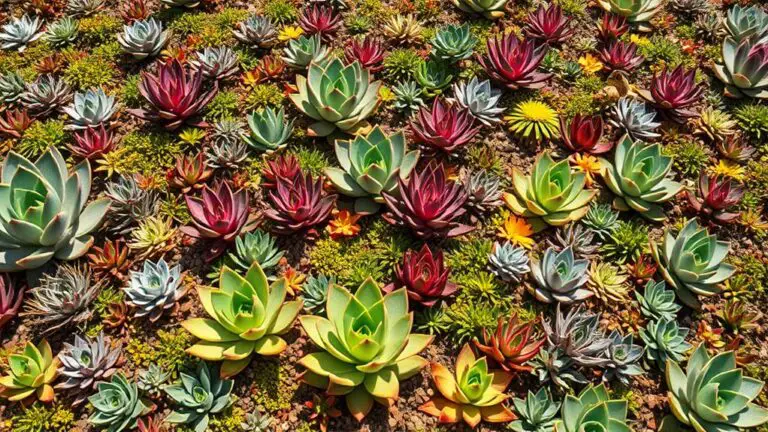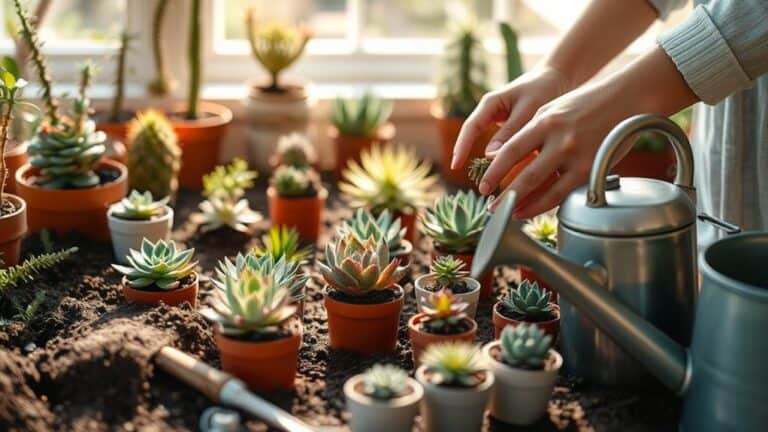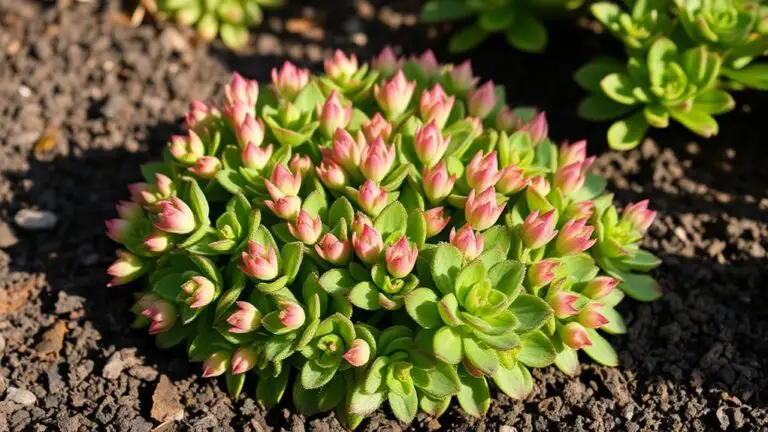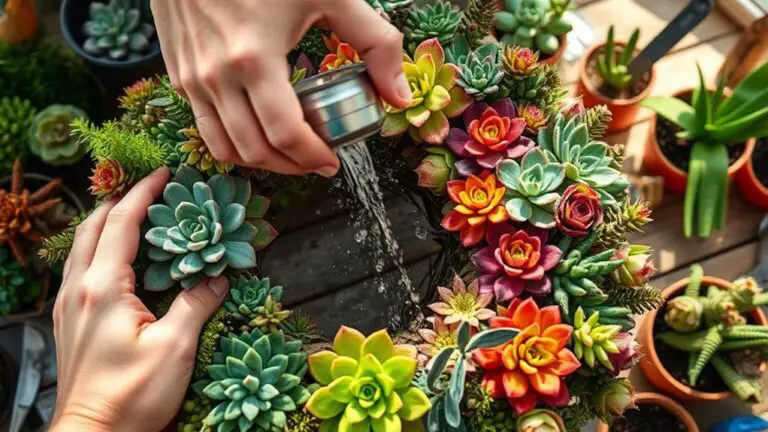Why Should You Use Totem Poles for Houseplants?
If you're looking to maximize the health and beauty of your indoor plants, totem poles might be just what you need. These structures offer essential support for climbing species, helping them grow vertically and mimic their natural environment. By encouraging better moisture and nutrient absorption through aerial root development, your plants will thrive more robustly. Additionally, totem poles allow you to make the most of your indoor space and add a unique visual element to your decor. But how do you choose the right one and maintain it? Let's explore further.
What Are Totem Poles?

Totem poles are vertical structures designed to support climbing and vining plants, mimicking natural tree environments to encourage upward growth. When you use totem poles, you're providing a sturdy foundation for your climbing plants, which helps them grow taller and healthier.
These poles can be made from various materials like moss, coir, or natural hardwood branches. Each material has its own benefits, such as better plant attachment and moisture retention.
Climbing plants often develop aerial roots, which need a solid structure to latch onto. Totem poles offer this support, allowing your plants to grow larger leaves and look more vibrant. Moss poles, in particular, are great because they hold moisture well, which is beneficial for the aerial roots.
Using totem poles also helps you maximize the space in your indoor garden. By growing plants vertically, you can make the most of limited space and create a lush, green environment in your home.
However, to keep everything thriving, regular plant care is vital. Misting and watering the totem poles will guarantee both the poles and your plants stay healthy.
Types of Totem Poles
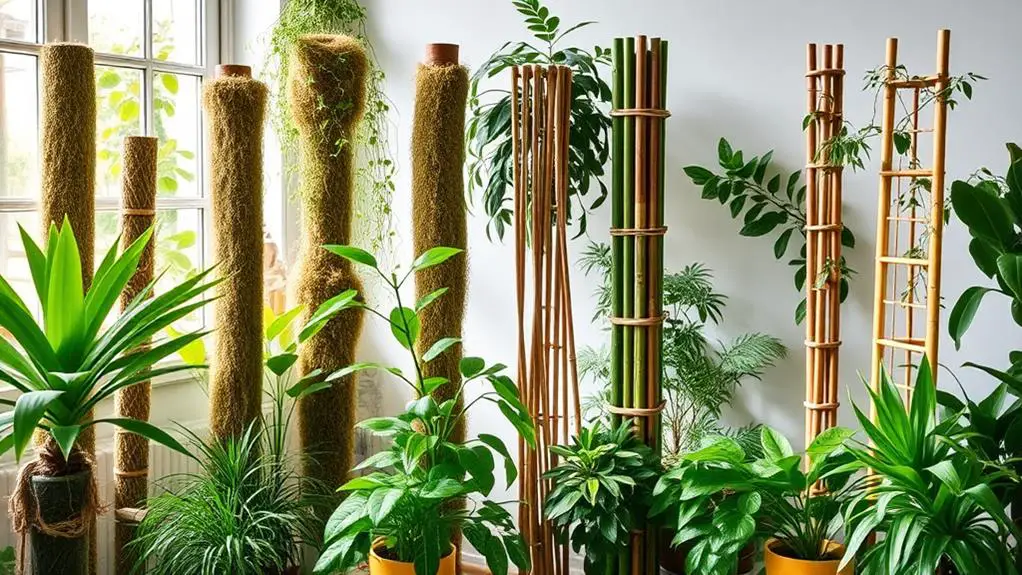
When choosing the right type of totem pole for your houseplants, consider your plant's specific needs and your maintenance preferences.
Moss totem poles are made from sphagnum moss and provide high moisture retention, making them perfect for moisture-loving climbing plants like Monstera and Pothos.
If you prefer something durable and sustainable, coir totem poles, constructed from coconut fibers, offer strong support for various climbing species while retaining some moisture.
For a rustic and eco-friendly option, natural branch totem poles utilize repurposed hardwood branches. They provide sturdy support for larger plants and add a unique aesthetic to your indoor garden.
Tree fern fiber poles, sourced sustainably from New Zealand, are less dense than traditional moss poles, making them suitable for delicate vines.
If you're up for a bit more care, live sphagnum moss poles require daily attention and high humidity but offer a fresh and vibrant appearance.
These are perfect for plant enthusiasts who enjoy hands-on maintenance.
Each type of totem pole caters to different plant needs and gardener preferences, so choose the one that best fits your lifestyle and plant care routine.
Materials Used in Totem Poles
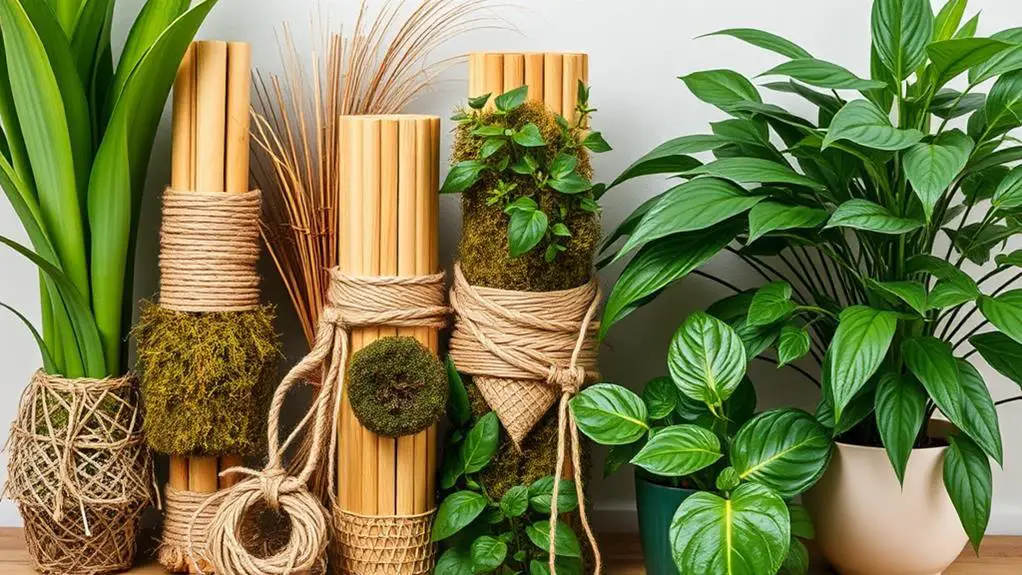
When choosing materials for your totem poles, you'll find options like sphagnum moss, coir (coconut fiber), and natural hardwood branches.
Moss poles are great for keeping your plants' roots moist, which is perfect for moisture-loving climbers.
Coir poles are durable and eco-friendly, while natural branches offer sturdy support and a rustic look, letting you pick the best fit for your plants' needs.
Common Totem Pole Materials
Considering the variety of materials used in constructing totem poles for houseplants, it's essential to choose one that best fits your plant's needs and your maintenance preferences. Different materials offer unique benefits, so knowing their properties can help you make an informed decision.
Moss poles, particularly those made from sphagnum moss, are perfect for moisture-loving climbing plants like Monstera and Philodendron. The moss provides excellent moisture retention, which is beneficial for plants with aerial roots. Coir poles, crafted from coconut fiber, are lightweight yet sturdy, making them a sustainable and durable option for humid environments.
Natural hardwood branches can be repurposed into totem poles, offering solid support and an organic aesthetic. These are great for those who prefer a natural look. Finally, tree fern fiber poles, sourced from New Zealand, are suitable for delicate vines but may not provide enough support for larger climbing plants.
Here's a quick comparison to help you choose:
| Material | Best For |
|---|---|
| Moss | Moisture-loving epiphytes |
| Coir | Humid environments |
| Natural Hardwood | Solid support, organic aesthetic |
| Tree Fern Fiber | Delicate vines, less sturdy |
Benefits of Moss Poles
Selecting the right material for your houseplant's totem pole can greatly impact its growth and health. Moss poles are a fantastic choice for your climbing plants. Made from sphagnum moss, these poles retain moisture effectively, which is vital for moisture-loving plants like Monstera and Philodendron.
The moss provides a damp environment that encourages aerial roots to attach and thrive, promoting healthier plant growth. When you use a moss pole, your climbing plants get the support they need to grow upward, which is their natural tendency.
This not only helps the plants grow stronger but also makes them look more attractive. Moss poles keep moisture close to the aerial roots, which means you won't have to water your plants as often.
Using moss poles can greatly enhance the overall health and aesthetics of your climbing plants. They provide the ideal combination of support and moisture, which is essential for robust plant growth.
While live sphagnum moss poles need daily spraying to stay fresh, traditional moss poles are less demanding. With the right care, your climbing plants will flourish, transforming your indoor garden into a lush, green oasis.
Choosing Sustainable Options
Choosing sustainable options for your houseplant totem poles not only benefits the environment but also guarantees your plants get the best possible support.
When you pick a Moss Pole, you're choosing an eco-friendly option made from preserved sphagnum moss. This moss retains moisture well, creating a natural environment for climbing plants to thrive.
Coir Totem Poles are another sustainable choice. Made from coconut fiber, these poles are durable and perfect for moist conditions. Coconut husks are renewable, making coir poles an excellent eco-friendly option for your indoor garden.
For a truly natural look, consider Natural Branch Totem Poles. These use repurposed hardwood branches, which are both sturdy and sustainable. They offer a strong support system while adding an organic aesthetic to your plant display.
Tree Fern Fiber Poles, sourced sustainably from New Zealand, provide a less dense option suitable for delicate vines. They're biodegradable, promoting a healthy, natural environment indoors.
If you like DIY projects, you can make your own totem poles using materials like PVC or wooden stakes combined with moss or coir. This allows you to customize your plant support while staying eco-friendly and sustainable.
Benefits of Totem Poles

Totem poles offer a multitude of benefits for houseplant enthusiasts, making them an important addition to any indoor garden. These supports are especially valuable for climbing plants, allowing them to grow naturally and develop aerial roots. This not only enhances the overall plant health but also encourages larger and more robust foliage.
If you have aroids like Monstera or Philodendron, you'll notice significant improvements in their growth and maturity.
One of the standout advantages of using totem poles is their ability to maximize vertical space. By growing upwards, your plants can become fuller without taking up additional horizontal area. This is perfect for those who've limited space but still want a lush, vibrant display in their homes.
Additionally, incorporating totem poles into your indoor garden boosts plant aesthetics. As your climbing plants intertwine with the pole, they create a beautiful, natural look.
Regular misting of the totem poles aids in moisture retention, which is vital for healthier root development. This simple practice guarantees that your climbing plants thrive, even in indoor environments.
Growth Support for Plants
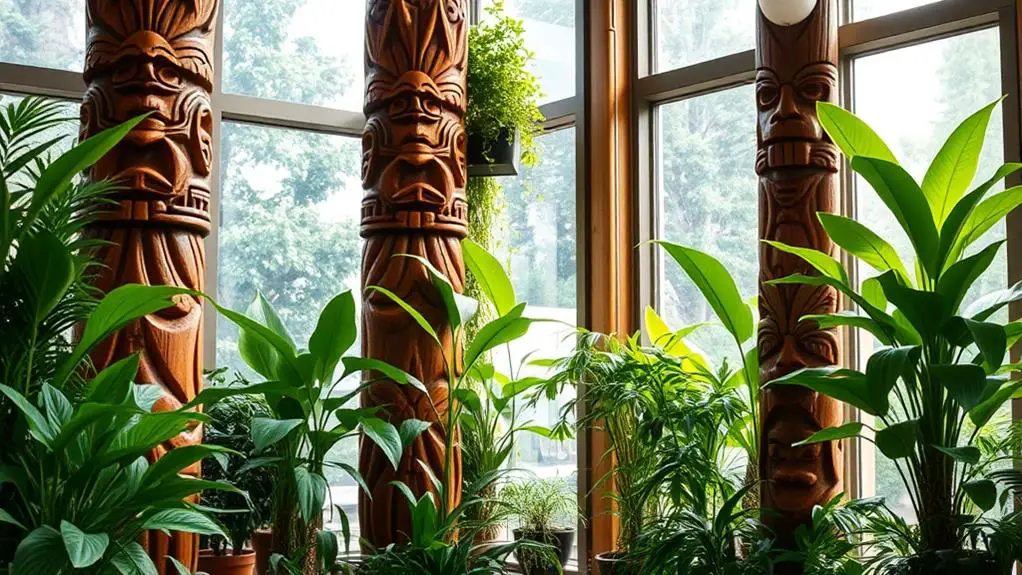
Using totem poles for your houseplants encourages natural climbing, which is important for plants like Monstera and Philodendron.
These poles also strengthen plant structure by promoting aerial roots that help absorb moisture and nutrients.
With better support, your plants will grow healthier and more stable, preventing them from bending or toppling over as they mature.
Encourages Natural Climbing
Vertical support structures like totem poles play an essential role in encouraging natural climbing habits in houseplants. When you use totem poles, climbing plants like Monstera and Philodendron can attach their aerial roots to the pole, mimicking their natural growth patterns. This vertical support helps your plants grow larger leaves and promotes healthier growth overall.
By providing support for climbing plants, totem poles help prevent leggy growth. Instead of sprawling out and becoming sparse, your plants will direct their energy upward, resulting in a fuller and bushier appearance. This natural growth isn't only better for the plant's health but also enhances its aesthetic appeal.
Totem poles also aid in the development of mature leaves and fenestrations, which are those beautiful cutouts you see in mature climbing plants. To get the best results, use soft ties to gently attach your plants to the pole. This guarantees that the aerial roots make good contact, allowing for better nutrient absorption and growth stability.
With totem poles, you're giving your climbing plants the support they need to thrive. It's a simple yet effective way to mimic their natural environment and encourage robust, vertical growth.
Strengthens Plant Structure
A sturdy support system is essential for the structural integrity of climbing plants. Totem poles offer that vital support, helping plants like Monstera deliciosa grow naturally and maintain stability. As your climbing plants develop, they need something to hold on to, and totem poles are perfect for this job.
Here's why totem poles are beneficial for plant structure:
- Vertical Growth: Totem poles guide your climbing plants upward, encouraging stronger stems and reducing the risk of bending or falling over. This is especially important for plants with heavy foliage.
- Moisture Retention: By regularly misting or watering the totem poles, you can enhance moisture retention, which supports the plant's structural integrity. Healthy, hydrated plants are less likely to suffer from weak stems.
- Aerial Roots Support: Totem poles encourage the attachment of aerial roots, helping plants like Monstera deliciosa and Philodendron achieve larger leaves and fenestrations. This not only strengthens the plant but also contributes to its overall health and maturity.
When you incorporate totem poles into your plant care routine, you're not just helping your plants grow tall and strong, but also making them more visually appealing.
You'll notice your climbing plants becoming fuller and bushier, creating a lush indoor garden.
Promotes Aerial Roots
Totem poles provide a sturdy, vertical structure that's perfect for supporting the growth of aerial roots in climbing plants like Monstera and Philodendron.
These climbing plants naturally seek out support, and totem poles offer the ideal surface for their aerial roots to attach and thrive. By mimicking the plants' natural habitat, you can create a supportive environment that enhances their overall health and growth.
When you use totem poles, the aerial roots of your climbing plants can effectively absorb moisture and nutrients from the surrounding environment. This promotes healthier growth patterns and results in larger leaves and more vibrant foliage.
To get the best results, mist the totem pole regularly. This maintains the necessary humidity, which is essential for the development of aerial roots and optimal plant health.
Introducing a totem pole early in your plant's growth cycle can greatly improve root attachment and stability. This leads to a more robust and visually appealing plant structure.
Space Efficiency Advantages

Leveraging totem poles for houseplants offers significant space efficiency advantages that can transform your indoor garden.
By encouraging vertical growth, totem poles allow you to maximize limited floor space. Instead of your climbing plants like Monstera and Philodendron spreading outwards, they grow upwards, creating a lush and fuller display without taking up extra room.
Using totem poles for your indoor plants also promotes healthier plants. When plants grow vertically, they get better air circulation and light exposure. This setup enhances growth and reduces the need for multiple containers, making it easier to manage your indoor garden.
Here are three key benefits:
- Maximized Floor Space: Totem poles enable vertical growth, freeing up floor space for other uses or additional plants.
- Healthier Growth: Better air circulation and light exposure lead to stronger, more vibrant plants.
- Consolidation: You can support multiple climbing plants in one pot, reducing the overall footprint of your indoor garden.
Aesthetic Appeal

While space efficiency is a significant advantage of using totem poles for houseplants, their aesthetic appeal can't be overlooked.
Totem poles add a vertical dimension to your indoor gardens, enhancing visual interest and creating a more dynamic display. Imagine your climbing plants gracefully winding their way up a rustic moss pole or natural branch. This natural growth not only looks beautiful but also complements the organic aesthetics of your home decor.
By using totem poles, you can create a sense of lushness and fullness in your plant growth. Climbing plants tend to develop healthier foliage and larger leaves when they've proper support. This results in a more vibrant and thriving indoor garden.
Plus, the integration of totem poles allows for unique design possibilities. You can mix and match various climbing plants to craft eye-catching focal points in your space.
Totem poles mimic natural growth environments, enhancing the overall aesthetic appeal of your indoor gardens. This promotes a cohesive and vibrant atmosphere, making your home feel more alive and welcoming.
Care and Maintenance Tips
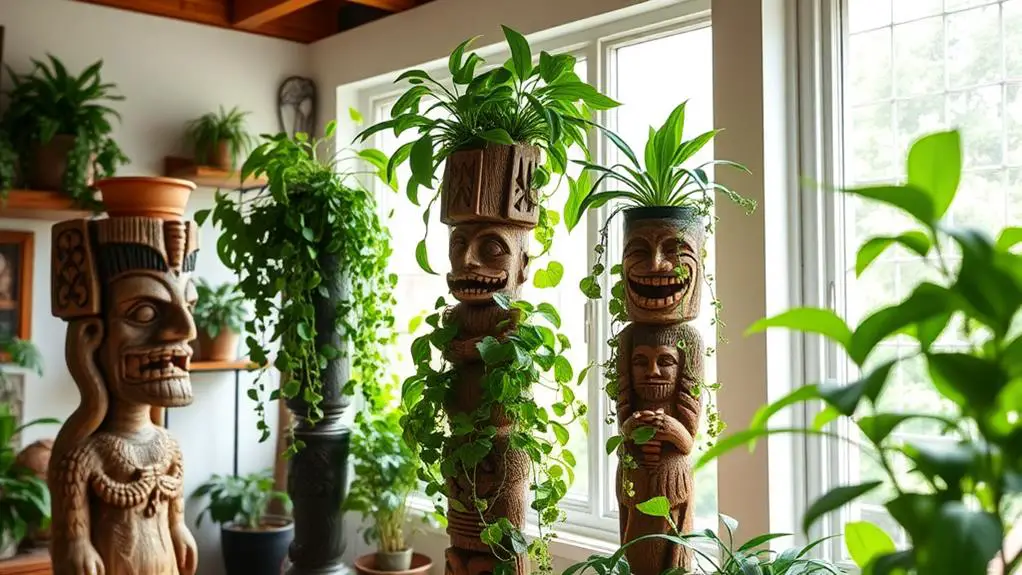
To keep your totem poles and climbing plants in top condition, it's important to prioritize regular care and maintenance. Start by regularly misting the poles to maintain moisture levels. This not only enhances humidity but also promotes healthy development of aerial roots along the pole. Keeping your totem poles moist will help your plants thrive.
Next, remember to inspect totem poles frequently for pests. Look for aphids and spider mites, and if you find any, treat them with insecticidal soap or neem oil. This will help keep your plants healthy and pest-free.
Here are three key care and maintenance tips:
- Support Stability: Use plant ties and stakes to provide support for larger plants. This prevents bending or toppling and reduces stress during growth phases.
- Weather Protection: Protect your totem poles from severe weather by using temporary shelters or coverings. Strong winds and heavy rain can damage both the poles and your plants.
- Material Maintenance: For moss or coir totem poles, regularly check moisture levels and replace the material as needed. This maintains consistent moisture retention and supports ongoing plant health.
Choosing the Right Totem Pole
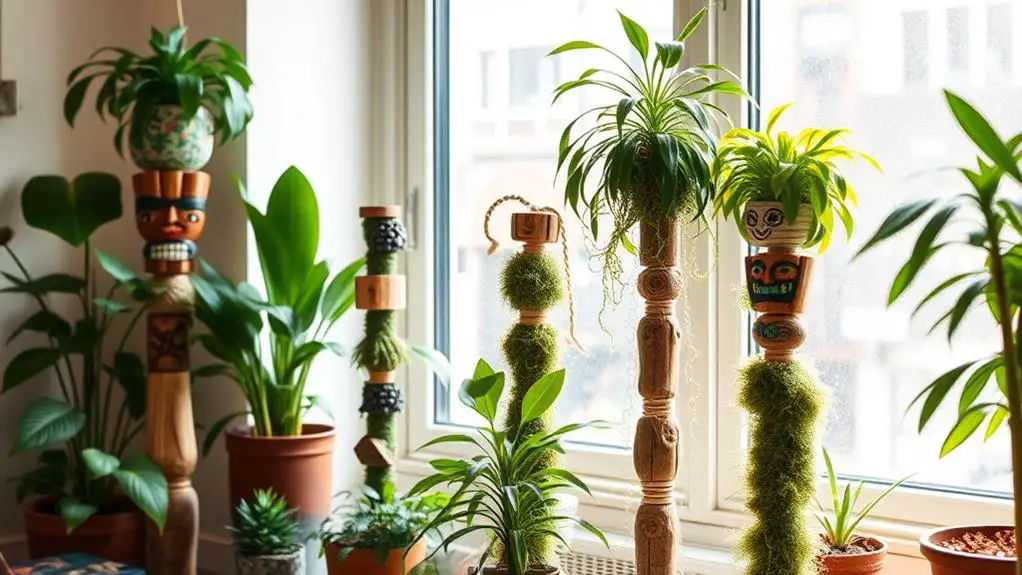
When selecting the right totem pole for your houseplants, it's important to take into account the specific needs of your plant species. For moisture-loving aroids like Monstera and Philodendron, moss poles made from sphagnum moss are perfect. They provide high moisture retention, which these plants love.
On the other hand, coir poles are great for various climbing plants due to their durability and decent moisture retention.
You should also consider the height of the totem pole. A taller pole can support your plant as it grows, making it ideal for larger plants. Shorter poles might be better for smaller varieties or young plants. It's vital to match the pole height with your plant's growth potential.
The material of the totem pole matters too. Sphagnum moss is excellent for retaining moisture, helping your climbing plants stay hydrated. Coco coir is a more sustainable option, though it retains less moisture, so keep this in mind for your plant's care.
Ensure the totem pole is securely anchored in the pot's soil. This provides stability, especially for larger or heavier plants.
A rough surface on the pole helps aerial roots attach better, enabling your plant to climb and thrive effectively.
Frequently Asked Questions
How to Use a Totem Pole for Plants?
Position the totem pole close to the plant's base. Secure it with soft ties at multiple points. Mist regularly to maintain humidity. Monitor soil moisture, letting the top dry out. Adjust the pole as the plant grows.
What Is the Main Purpose of Totem Poles?
You should know the main purpose of totem poles is to provide vertical support for climbing plants. They help plants grow naturally, encouraging healthier development and optimizing indoor space by promoting upward growth instead of outward sprawl.
Why Use Moss Poles for Monstera?
Use moss poles for Monstera to replicate their natural climbing habitat. They support aerial roots, provide stability, retain moisture, and promote healthy growth and mature foliage. You'll see larger, more vibrant leaves with beautiful fenestrations.
What Are the Benefits of Moss Sticks for Plants?
You'll love using moss sticks for your plants because they replicate natural growth conditions, keep roots hydrated, and promote larger, mature foliage. They also enhance aesthetics and maintain humidity levels, ensuring your plants thrive and look lush.
Conclusion
Incorporating totem poles into your indoor garden is a smart move. They support your plants' growth, save space, and add a touch of beauty to your home. With regular care like misting, your plants will thrive and stay healthy. Choose the right totem pole for your plant, and watch your indoor garden flourish. You've got this! Enjoy the process and see your green friends grow strong and happy. Happy gardening!



